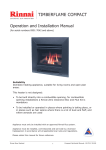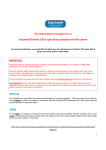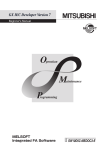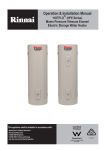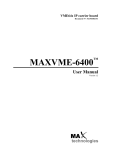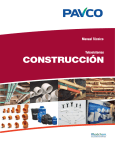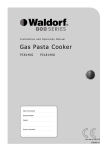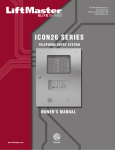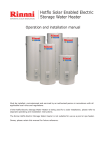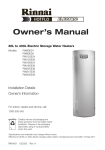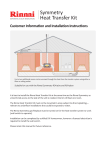Download Rinnai SPLIT SOLAR Installation manual
Transcript
Solar Split System Installation Manual Hotflo Glass Lined Tank, E-Frost Collector, Gas and Electric Boost • Must be installed, commissioned and serviced by an authorised person in accordance with all applicable local rules and regulations. • Power supply must be available to the system at all times Limited Warranty Rinnai solar warranty summary table Solar Collector Domestic Application Commercial Application Parts 7 years 5 years Labour 1 year 1 year rinnai infinity: Domestic models (white) Domestic Application Commercial Application Parts 10 years pro rata 1,500 hours or 1 year* Labour 3 years 1,500 hours or 1 year* Parts 3 years 1,500 hours or 1 year* Labour 3 years 1,500 hours or 1 year* Domestic Application Commercial Application Parts 12 years pro rata 5,000 hours or 3 years* Labour 3 years 1,500 hours or 1 year* Parts 5 years 1,500 hours or 1 year* Labour 3 years 1,500 hours or 1 year* Domestic Application Commercial Application Parts 5 years 3 years Labour 3 years 3 years Parts 1 year 1 year Labour 1 year 1 year Heat Exchanger All Other Parts rinnai infinity: Commercial models (silver) Heat Exchanger All Other Parts * Whichever comes first storage tank Tank All Other Parts* * Pumps, controllers, valves etc. All terms of the warranty are effective from the date of installation of the Rinnai solar system. Rinnai New Zealand Limited (Rinnai) reserves the right to verify this date by requesting a copy of the Certificate of Compliance obtained by local building authority inspection of the system. Domestic vs. commercial application The reason for distinguishing between a domestic and commercial application is because the expected life of a system is directly related to the hours of use. A domestic application is defined as an installation that serves a single residential dwelling which is not used for commercial purposes, such as a hair salon, catering kitchen, motel or communal care facility. All other installations are defined as a commercial application. Limited Warranty General warranty terms Rinnai reserves the right to make modifications and change specifications and its parts without notice. For the purposes of the Consumer Guarantees Act 1993, Rinnai only guarantees the availability of repair facilities and spare parts for the express warranty periods recorded in the Rinnai Solar Collector Warranty Table. If the Rinnai solar system is being acquired for personal, domestic or household use, this warranty does not limit any consumer rights or guarantees that may apply under the Consumer Guarantees Act 1993. If the product is being acquired for the purposes of a business, the provisions of the Consumer Guarantees Act 1993 do not apply and no other warranties (either express or implied by law) apart from those stated in this warranty apply. Rinnai warranty terms for solar components Water quality for Rinnai Infinity and solar collectors Water quality outside the maximum recommended limits (as set down below) will void this warranty. Water quality tests must be carried out at the customer’s own cost but Rinnai will reimburse any reasonable test costs where water quality is within the limits tabled. TDS (Total Dissolved Solids) Total Hardness CaCO3 Alkalinity (as CaCO3) Dissolved (free) CO2 pH Chlorides Magnesium Sodium Iron Langelier Index Up to 600 mg/L or ppm Up to 200 mg/L or ppm Up to 200 mg/L or ppm Up to 25 mg/L or ppm 6.5-8.5 Up to 300 mg/L or ppm Up to 10 mg/L or ppm Up to 150 mg/L or ppm Up to 1 mg/L or ppm Between -1.0-0.8 Most metropolitan water supplies fall within these limits. If you are unsure about water quality, please contact Rinnai and we will provide you with the details of an authorised agency able to test your water for compliance to Rinnai standards. If sludge or foreign matter is present in the water supply, a suitable filter should be incorporated in the water supply. Some examples of water quality issues where water may need to be treated: • • • Hard water (areas including Wanganui) Aggressive water (areas including Christchurch) Both hard and aggressive water (some bore water) In relation to solar collectors E-Frost collectors are warranted against frost damage caused by temperatures down to and including -15 °C where power is available to the system and the system is configured for low temperature mode (factory default). It is conditional that power is available and switched on. Failure due to lack of power supply or changes to the temperature mode settings are not covered. Limited Warranty In relation to storage tanks The following exclusions apply: • Accessibility Where the cylinder is not easily accessible for maintenance and replacement, this warranty will not cover any additional costs caused by access difficulty • Leaks To the fullest extent permitted by law, this warranty does not cover any consequential loss resulting from leaks to a cylinder. Accordingly it is important that a suitably drained catch pan is fitted where damage could be caused by discharge from the cylinder. Warranty exclusions The following exclusions may cause the warranty to become void and will result in a service charge and costs of parts (if required). 1. Accidental damage and acts of God. 2. Failure due to abuse or misuse, improper maintenance or improper storage. 3. Failure due to incorrect or unauthorised installations. 4. Failure or damage caused by alterations, service or repair work carried out by persons other than Rinnai service persons or service centres. 5. Where the solar component has failed directly or indirectly as a result of poor water quality outside the limits specified. 6. Where it is found that there is no fault with the solar component(s) and the issue is related to the installation or failure due to lack of power supply. 7. Subject to any statutory provisions to the contrary, Rinnai does not accept: a. liability for consequential damage or any incidental expenses resulting from any breach of the warranty, b. claims for damage to building or any other consequential loss either directly or indirectly due to leaks from the solar components or any other faults. G12/AS2 durability As required by the New Zealand Building Code compliance document G12/AS2, clause 7.2.3, in respect of the durability of the solar system components supplied by Rinnai, Rinnai makes the following statements. a. The collector mounting rails have a durability of fifteen years provided they are kept clear of debris such as leaves. B. All other components of the system supplied by Rinnai may require maintenance and/or replacement before fifteen years. Contents Introduction 6 Suitability for use 6 Solar collector fittings kits 7 Solar tank fittings kit 8 Cylinder location 9 Cylinder connections 10 Mounting the solar controller and pump 11 Mounting collectors on the roof - general 13 Mounting collectors on a metal roof 15 Mounting collectors on a tile roof 18 Fitting connecting pipes and sensor lead 19 Supplementary boosting - gas 20 Supplementary boosting - electric 21 Commissioning the solar system 22 Consenting requirements for solar 23 WARNING Improper installation, adjustment, alteration, service or maintenance can cause property damage, personal injury or loss of life. For assistance or additional information contact Rinnai on 0800 RINNAI (0800 746 624). Introduction This manual is intended to be used by Rinnai accredited solar installers, who have a good understanding of the different types of solar systems and how they operate. The information contained is designed to reinforce information from the TradeSmart Solar Training Course, provide an understanding of the Rinnai Solar System, its suitability for use and high level instructions for installation. This manual should be used in conjunction with the following codes and standards: • AS/NZS 3500.4 (Heated Water Services) Section 5 - General Installation Section 6 - Solar • G12/AS2 (DBH Acceptable Solution for Solar Installation) Suitability for use Water quality Requirements must meet the standards for Rinnai solar products (refer warranty information). Hard or aggressive water will need to be treated in order to use this product. Water pressure The flowing water pressure in the dwelling needs to exceed the height of the solar collectors. For example, of the highest point of the solar collector is 7 m above the incoming water, then the water pressure needs to exceed 70 kPa to keep the collectors full. Maximum water pressure = 1000 kPa Roof pitch and condition E-Frost collectors perform best at roof pitches ≥ 20°. At lesser pitches performance will be degraded. This manual does not cover installations that may require frames for flat, side, or reverse pitch roofs. Any damage to the roof must be repaired prior to installation of the solar collectors. Pumped systems only E-Frost collectors are not suitable for close coupled hot water solar systems. Rinnai New Zealand Limited E-Frost Solar Collector Split System Install Manual: 11497-A Solar collector fittings kits These are all the components for plumbing and mounting collectors on the roof. Included Not included (to be supplied by the Installer) • • • • • • • • All Plumbing Fittings Air Release Valve Hot Sensor Temperature Pocket 15 m of Hot Sensor Lead Angled Mounting Rails for Panels Straps M5 Fasteners (guide stoppers for panels) Mounting Fasteners Hot outlet connection The Rinnai standard mounting rails are for arrangements where the hot outlet connection is on the top right hand corner. If you have an arrangement that requires a top left hot outlet connection you will need a different top mounting rail. This can be purchased as an accessory from Rinnai. Stainless steel straps for tile roofs G12 requires stainless steel straps for tile roofs. The Split System Solar Fittings Kits have galvanised straps as standard. If collectors are being installed on a tile roof, stainless steel straps can be purchased as an accessory item. Example of the solar collector fittings for a two solar collector installation Rinnai New Zealand Limited E-Frost Solar Collector Split System Install Manual: 11497-A Solar tank fittings kit SOLKITPUMPGE1 contains all the components for plumbing on and around the storage cylinder. Included Not included (to be supplied by the Installer) • • • • • • • • • • • • • Pump Solar Controller Cold Outlet Fittings Cold Sensor Lead Dip Tube Crox Nuts to make the following connections: • Cold Water Inlet: 20 mm copper pipe • TPR Valve Drain Line: 15 mm copper pipe Compression Fittings to make the following connections: • Cold Inlet to Pump: 12 mm (od) copper tube • Pump to Solar Panel: 12 mm (od) copper tube • Solar Panel to Storage Cylinder: 12 mm (od) copper tube Pressure Limiting Valve Cold Water Expansion Valve Filter Shut-Off Valves Catch Pan Tempering Valve Seismic Restraint Timer for Electric Element Copper tube or insulation to connect between the: • Cold Inlet and Pump • Pump and Solar Panel • Solar Panel and Cylinder Return (od = outside diameter) Pump provided in kit Laing S1-15/700B 230V pump or Grundfos UP15-14B. A powerful pump is not needed in a standard Rinnai solar system as the pump is only required to circulate water slowly through the panels to maximise solar efficiency. Tempering valve Ensure this is suitable for use with solar systems. Many suppliers have a dedicated solar range to handle the higher temperatures. Pipe insulation Needs to be adequate to handle high temperatures and should be protected with UV resistant tape. Dip tube to solar enable tank The Hotflo tanks do not come solar enabled. This needs to be done during installation using the dip tube provided in the tank kit. Enabling the Hotflo tank for solar installations is an easy one step process by inverting the riser tube in the tank. Rinnai New Zealand Limited E-Frost Solar Collector Split System Install Manual: 11497-A Cylinder location Inside or outside The Rinnai Glass Lined storage cylinders are suitable for mounting either inside or outside. Relevant regulations Cylinders should be installed to AS/NZS3500.4, with reference to G12/AS1 where appropriate. Base requirements Cylinders should be installed on a flat level base of sufficient strength to support the weight of the water heater when full. It must also be suitably restrained against seismic activity. Access to cylinder Cylinders should not be located where they will be difficult to remove, such as in attic spaces or built into cupboards or shelves. Tank durability is part of B2/AS1 1.2.1c) where there is a requirement that there is no removal of building elements in order to gain access. Where a cylinder is not easily accessible for maintenance and replacement, the Rinnai Warranty will not cover any additional costs caused by access difficulty. This is important for glass lined tanks where access is required to change the anode at the top of the cylinder. Catch pan It is important a suitably drained catch pan is fitted where damage could be caused by discharge from the cylinder. The Rinnai Warranty does not cover any consequential loss from leaks to the cylinder if a catch pan isn’t installed. Electrical connections Timer for electric boost systems ▪ A single phase 3 pin power point is required to power the solar pump and controller ▪ If electric boost is used, a 16 Amp power supply from the distribution board will be required to boost the element ▪ If gas boost is used, a second power point will be required to power the Rinnai Infinity ▪ Ensure there are no connections to the ripple relay A timer1 on the 16 Amp power circuit is required to control the electric boost to ensure maximum solar gain. There are many different models of timer available, a straight pre-programmed timer, or with an over-ride button to allow the customer to initiate a boost at times of low solar gain. It is important to discuss the timer with the customer as they will need to have one installed that will suit their hot water requirements. 1 Merlin Gerin (IHP+1C 18 mm) or PDL 7 Day Electronic Timer Rinnai New Zealand Limited E-Frost Solar Collector Split System Install Manual: 11497-A Cylinder connections Pressure limiting valve ▪ ▪ Rinnai Glass Lined 180 litre Rinnai Glass Lined 270 and 340 litre - 700 kPa - 500 kPa Cold water pressure relief valve ▪ ▪ Rinnai Glass Lined 180 litre Rinnai Glass Lined 270 and 340 litre - 850 kPa approximately - 700 kPa approximately Temperature & pressure relief valve (TPR) ▪ ▪ Rinnai Glass Lined 180 litre Rinnai Glass Lined 270 and 340 litre - 1000 kPa [supplied with cylinder] - 850 kPa [supplied with cylinder] Drain valve Provision must be made to drain the cylinder if required for servicing. Drain lines These must be installed in accordance with AS3500 and or G12/AS1. G12 is available online at no cost from: www.dbh.govt.nz/building-code-compliance-documents Tempering valve During times of high solar gain water temperatures in solar systems can become very high. A tempering valve will be required. Ensure that it is suitable for use with solar systems. Many suppliers have a dedicated solar range to handle the higher temperatures. Rinnai New Zealand Limited 10 E-Frost Solar Collector Split System Install Manual: 11497-A Mounting the solar controller and pump 1. Mount the solar controller in a suitable position on the side of the cylinder or adjacent wall using suitable fasteners. 2. Change position of the riser tube to solar enable the Hotflo storage cylinder using the dip tube provided in the tank fittings kit. - Select which upper hot outlet will be used for the hot solar return - Invert the riser tube using the wire tool supplied 3. Fit the plumbing fittings as shown below and in the drawing on the back of the fittings kit Rinnai New Zealand Limited 11 E-Frost Solar Collector Split System Install Manual: 11497-A Mounting the solar controller and pump 4. Run a piece of insulated 12 mm od copper tube from the cold inlet to the pump. Ensure the pump is installed correctly with the impeller in a vertical not horizontal position. 5. Uncoil the cold temperature sensor in the control box and feed it out of the gland in the bottom of the control box. Do not attach it to the pipe work until the commissioning stage. 6. Set pump controller for panel type. This controls the hot water circulation for frost protection. Solar Control Box with Switch Positions Marked Solar Controller Settings Hot Water Circulation CIRC/DUMP FPOFF/FPON CIRC FPON Other settings are not recommended. 7. There are three power warning labels (see below) supplied with the solar collector fittings kit. Place these adjacent to the power main switch, the circuit breaker controlling the outlet into which the pump is connected and on the cover of the control box. Ensure the consumer is aware that the system frost protection will be reduced if the power is not available. Frost Protection - Electricity Required Label IMPORTANT This house has a solar panel which requires power to prevent damage in freezing conditions. DO NOT DISCONNECT POWER if there is a likelyhood of freezing without draining the panel. Contact your solar supplier or Rinnai Service agent who can drain the panel safely. Phone: 0800 RINNAI / 0800 746 624 8. Do not connect the power lead to the power supply at this stage. Rinnai New Zealand Limited 12 E-Frost Solar Collector Split System Install Manual: 11497-A Mounting collectors on the roof - general Roof sizing and collector weight Each Rinnai solar collector is approximately 2 m tall by 1 m wide. Select a location with sufficient space for the collectors and associated plumbing connections. The collectors weigh approximately 40 kg each and due care and skill should be taken when lifting them onto the roof. Roof inspection required before installation Inspect the roof before commencing installation and draw the attention of the customer to any existing damage. Arrange repair before installation. Collector angle and positioning Mount the collectors on a suitable North facing roof surface. Select a location where shading from adjacent buildings and trees will be minimised. As per G12, AS2, Figure 2, paragraph 4.1 Solar water heaters must be located away from the edge of the gable roof structure outside the high pressure wind zone as shown. In order to assist circulation and prevent air-locking, each collector must slope upwards 8-10 mm from inlet to outlet as shown. The mounting rails supplied in the collector fittings kit will enable this to occur. Hot connection Cold connection mm slope upwards 8-10 Each collector must Collectors must be securely fastened to the roof, refer following pages. Rinnai New Zealand Limited 13 E-Frost Solar Collector Split System Install Manual: 11497-A Mounting collectors on the roof - general Pipe connections between collector and tank Hot collectors WARNING ▪ Connecting pipes should pitch up continuously from the tank to the collector to prevent air-locking ▪ Insulation should be of a suitable material to withstand high temperatures in solar systems and be protected with UV resistant tape or other coating ▪ Maximum total flow and return pipe length between cylinder and collector is 50 m The surface and frames can become extremely hot. Collectors should be kept covered while handling and suitable protective clothing including gloves must be used to prevent burns. Keep collectors covered until commissioning and leak testing of the system is complete. Rinnai New Zealand Limited 14 E-Frost Solar Collector Split System Install Manual: 11497-A Mounting collectors on a metal roof The Rinnai standard mounting rails are for arrangements where the hot outlet connection is on the top right hand corner. If you have an arrangement that requires a top left hot outlet connection you will need a different top mounting rail. This can be purchased as an accessory from Rinnai. Unpainted galvanised roofs will require painting under the area where the collector is installed and any subsequent run off areas (e.g. down the guttering below). 1. Check purlin size Check purlins are a minimum size of 50 x 50 mm. If there are no sufficiently sized purlins available at the correct centres they can be added between the rafters or trusses at the correct spacing. 2. Position top collector Establish the position at a suitable purlin, usually identified by a row of fasteners. The assembled collectors should cross as many rafters as possible and be evenly distributed across them. 3. Fasten top mounting rail Fasten with the bottom edge level and horizontal as shown below. Use a minimum of 8 x 8 gauge fasteners per collector. Two are secured into the purlin with the balance either into the purlin or metal roof cladding. Each fastener should have a suitable EDPM or similar washer under its head and between the rail and roofing material. There should be no metal to metal contact between the roof and rail. il Top mounting ra Level 4. Mark position for strap hooks and secure Measure down the roof from each end of the top rail and mark the position for the strap hook as follows: Fit strap hook approximately 75 mm in from each edge of the mounting rail. Screw both straps to the roof using a minimum of 4 x 8 gauge fasteners per strap. Trim off any excess length. At least one fastener per strap must be attached to a purlin. Use EDPM washers underneath to avoid direct contact between the strap and the roof. Rinnai New Zealand Limited 15 E-Frost Solar Collector Split System Install Manual: 11497-A Mounting collectors on a metal roof 5. Fit lower mounting rail to the straps Fasten the lower mounting rail through the straps to the roof and in additional places as required. Check the distance between the inside faces of the mounting rails is correct. 6. Fit additional Fit additional straps so there are two straps per collector. Each fastener straps as should be sealed with suitable washers, both under the head of the required fastener and between the rail and roof, as shown below. Rinnai New Zealand Limited 16 E-Frost Solar Collector Split System Install Manual: 11497-A Mounting collectors on a metal roof 7. Fit collectors To assist in fitting the collectors there are a series of M5 threaded holes along the mounting rails. In the solar collector fittings kit are M5 fasteners. These should be inserted into the holes in the rail before the collectors are fitted. These will act as ‘stoppers’. Fit the collectors into the mounting rails. The stoppers will position the panels at the right height for the slots to align so the mounting fasteners can insert easily. The stoppers should be removed after the collectors are fitted. Use lower holes 8. Fit additional collectors Fit the first collector between the mounting brackets using fasteners supplied, do not fully tighten at this point. Fit the collector connectors for two or three panel systems to the first panel. Fit second collector by inserting the header tubes into the connectors and attach the collector to the rail with fasteners provided. Tighten fasteners on the first collector. Firmly push collectors together, tighten connectors and then tighten fasteners on second collector. Repeat from step 7 if fitting a third panel. Rinnai New Zealand Limited 17 E-Frost Solar Collector Split System Install Manual: 11497-A Mounting collectors on a tile roof The Rinnai standard mounting rails are for arrangements where the hot outlet connection is on the top right hand corner. If you have an arrangement that requires a top left hot outlet connection you will need a different top mounting rail. This can be purchased as an accessory from Rinnai. G12 requires stainless steel straps for tile roofs. The Split System Solar Fittings Kits have galvanised straps as standard. If collectors are being installed on a tile roof, stainless steel straps can be purchased as an accessory item. Determine position for top mounting rail The assembled collectors should cross as many rafters as possible and be evenly distributed across them. The top rail should be approximately in the middle of a line of tiles. Mark a horizontal line at the determined position. Measure down the roof from the top line for the respective collector. Check that the lower line does not coincide with an edge of tiles. If necessary adjust the position of the upper line slightly to prevent this happening. The procedure is the same as for the metal roof with the exception that the top mounting rail is also fastened using straps. Additionally there should be no need to use spacers to prevent the rails touching the tile roofing. Tile removed m 0m 8 19 st Fro E- Rinnai New Zealand Limited tor ec ll co Four fasteners Bottom edge of top rail to be level 18 E-Frost Solar Collector Split System Install Manual: 11497-A Fitting connecting pipes and sensor lead All penetrations through the roof for connecting pipes and hot sensor lead should be made using suitable sealing boots such as dektites. 1. Attach plumbing fittings Run piping and insulate Attach necessary plumbing fittings to the collector(s) as shown below. Compression fittings are designed for 12 mm outside dimension (od) copper tube. Run and insulate piping between the pump outlet and bottom left corner of the collector(s). Run and insulate piping between hot sensor lead connector on top right hand corner of collectors to the hot return at the storage cylinder. The piping should pitch continuously upwards to the collectors to prevent air-locking. 2. Insert hot sensor lead Insert hot sensor lead into the pocket on the fitting on the top right corner of the collector(s) and secure in place with suitable high temperature silicon. The other end of the assembly is run through a fitting on the bottom side of the solar pump and controller box and attached to the mating electrical connector on the solar controller. Longer leads of 30 m length are available from Rinnai as an accessory, or the lead can be terminated and extended using two core sheathed (double insulated) flex with conductors of 0.5 mm2 (minimum cross section area). Rinnai Solar Collector Fittings Kit Assembly - Two Collectors Hot sensor lead Rinnai New Zealand Limited 19 E-Frost Solar Collector Split System Install Manual: 11497-A Supplementary boosting - gas Install a Rinnai continuous flow water heater using a flow diversion valve as shown below. The water heater must be set to 75 oC. All Rinnai Infinity units installed in a solar system require a flow diversion valve and a dipswitch change to the required 75 oC. (Remember ‘B to Boiler’ when setting up the flow diversion valve). Rinnai water controllers cannot be used with Rinnai Infinity units connected to solar systems as the: • • Hot water does not always pass through the Rinnai Infinity Rinnai Infinity preset dip switch setting of 75 oC is unable to be adjusted. Recommended system layout using a Rinnai Infinity and flow diversion valve Configuring the System to Protect for Legionella If the system is configured according to the details above it will meet the requirements of the Acceptable Solution G12/AS2 for protection against Legionella. This states that “the instantaneous water heater must heat all water passing through it to not less than 70 °C.” Rinnai New Zealand Limited 20 E-Frost Solar Collector Split System Install Manual: 11497-A Supplementary boosting - electric All Rinnai storage cylinders come pre-equipped with electric elements and thermostats. Electrical connections The cylinders are pre-wired. A 20 mm mounting hole for conduit termination is provided under the element cover. A 2 way terminal block is provided for connection of Active and Neutral wires (pictured) and a brass terminal block is provided for connection of the earth cable. Timer To gain the most effective solar contribution the element is usually controlled by a timer placed in the circuit as shown below. There are a number of commercially available timers1, consult your electrical supplier. Ensure the timer contacts have sufficient rating to switch the load. This will be approximately 15 Amps for a 3600 Watt element. 1 Examples: Merlin Gerin (1HP+1C 18 mm) or PDL 7 Day Electronic Timer Representation of how a timer would be set up in a circuit Configuring the System to Protect for Legionella G12/AS2 states that effective Legionella protection can be gained by heating the cylinder to at least 60 oC once a day, and the element is in the bottom 20% of the water tank (by volume) and no more than 150 mm from the bottom of the tank. To meet this requirement and provide a sufficient quantity of hot water for the customer, the timer can be set to provide electricity to the cylinder from 9pm to 5am. This will ensure a full tank of hot, Legionella free water every morning. Rinnai New Zealand Limited 21 E-Frost Solar Collector Split System Install Manual: 11497-A Commissioning the solar system Until system filling and commissioning is complete: WARNING • Keep solar panels covered • Do not plug in the solar controller / pump or connect a power supply to boost the element until step 6 1. If a gas boost is fitted, open the inlet and outlet water valves at the Rinnai Infinity but do not connect the power supply at this point. 2. Open a hot tap at the sink. 3. Open the cold water inlet to the storage cylinder. 4. Keep the hot tap open until non-aerated water appears at the sink. 5. Taking care to avoid potentially scalding water, open the air bleed valve on the temperature sensor pocket on the top right hand corner of the solar panel(s). 6. Plug in the power lead from the solar controller / pump. If the hot temperature sensor is 9 oC hotter than the cold temperature sensor the pump should start. If this is not the case, cool down the cold temperature sensor in a cup of ice. If this is still not sufficient to create the 9 oC differential, a spare hot sensor lead can temporarily be connected to the pump controller and warmed until the pump starts. 7. Leave the air bleed valve open with the pump running until non-aerated water appears at the bleed valve. Close the air bleed valve. 8. The coverings can now be removed from the solar panel(s). 9. Tape the cold sensor to the T on the inlet of the cylinder. Fit suitable insulation material over the sensor and fasten in place. 10. Fit the pump and controller cover. 11. For an electric boost system, program the timer as required, set the thermostat to between 60 and 70 oC and replace the element cover. 12. For a gas boost system, connect the Rinnai Infinity to power and gas, and commission in accordance with the instructions supplied with the water heater. Rinnai New Zealand Limited 22 E-Frost Solar Collector Split System Install Manual: 11497-A Consenting requirements for solar The following information is from the EECA Solar Water Heating Guidebook, Version 1, October 2006, Section 2. The installation of a solar hot water heating system requires a Building Consent because solar water heating systems interact with potable water supplies and can involve heavy loads on roof structures if the hot water cylinder is mounted on the roof. A Building Consent is also required where there is a change to a potable water supply system and to the heat source. Other permits may be required to cover electrical alterations, or where there is a building height restriction. All plumbing work will require certification by a craftsman plumber. A registered electrician will need to certify any electrical work that may be needed. Certifications may be in the form of a Producer Statement as required by the Building Consent. Solar water heating installers should ensure that any necessary Building Consents are obtained and adhered to. An installer must then be able to demonstrate to the Consent Authority that the installation meets the requirements of the New Zealand Building Code. • For new dwellings, the solar water heating system is usually included in the overall consent for the building. In this case the plumbing approval is usually done by the designer, specifier or the plumbing contractor. Structural approval is done during the process of approving the design of the trusses with the trusses merchant, by taking into account the specific load of the hot water cylinder (not applicable if the system does not have a cylinder on the roof). • For installing solar water heating on existing dwellings, the installers usually provide a signed Producer Statement confirming they have installed the solar water heating system according to the requirements of the New Zealand Building Code. If the hot water cylinder is not on the roof, the Building Consent should be submitted as a minor plumbing alteration. However, when the cylinder is on the roof, the city council will require evidence that the existing structure can cope with the load. System suppliers often provide pre-prepared supporting documentation to accompany an application to help installers obtain Building Consents with the minimum effort. The documentation may include acceptable structural support arrangements for specific system models. Rinnai has developed a G12 AS2 Rinnai Solar Compliance document to assist with the consent process. This can be found on our technical website www.rinnai-tradesmart.co.nz within the Solar section. Rinnai New Zealand Limited 23 E-Frost Solar Collector Split System Install Manual: 11497-A Consumers: Installers: 0800 RINNAI (746 624) 0800 TO RINNAI (86 746 624) Address: 105 Pavilion Drive, Airport Oaks, Mangere, Manukau PO Box 53177, Auckland Airport, Manukau 2150 Phone: Fax: (09) 257 3800 (09) 257 3899 Email: Websites: [email protected] www.rinnai.co.nz and www.rinnai-tradesmart.co.nz All Rinnai appliances meet or exceed the safety standards required by New Zealand gas and electrical regulations. Rinnai is constantly improving its products and as such information and specifications are subject to change or variation without notice.

























